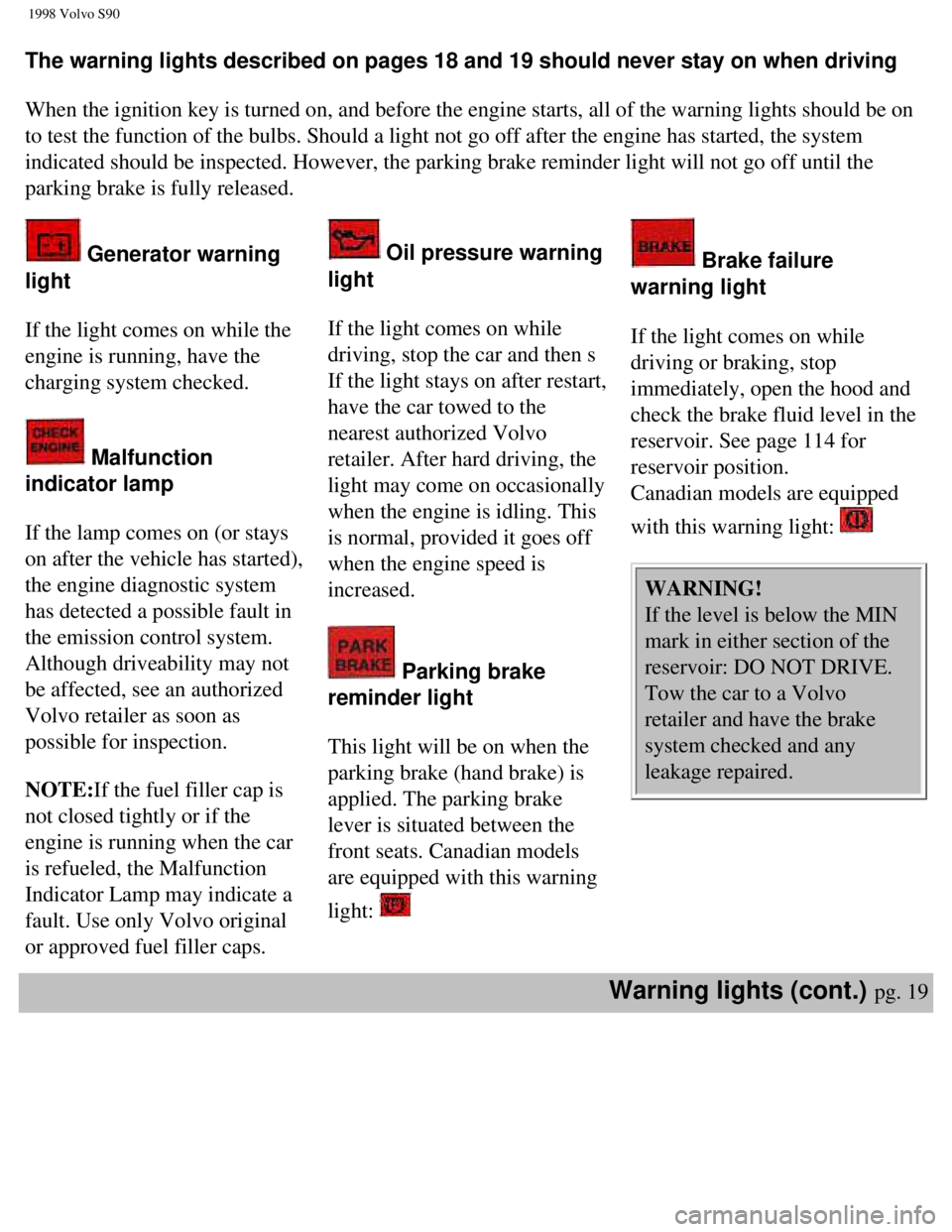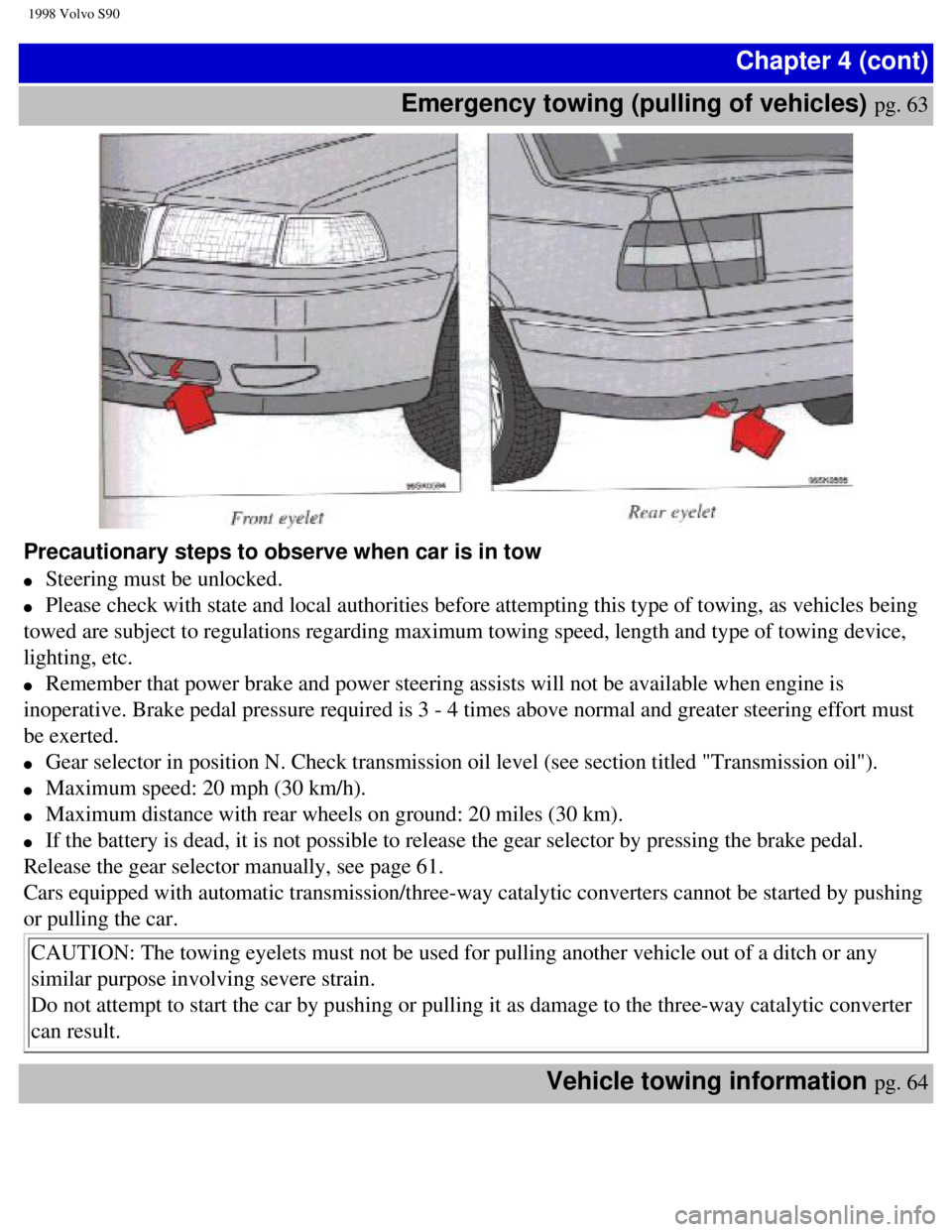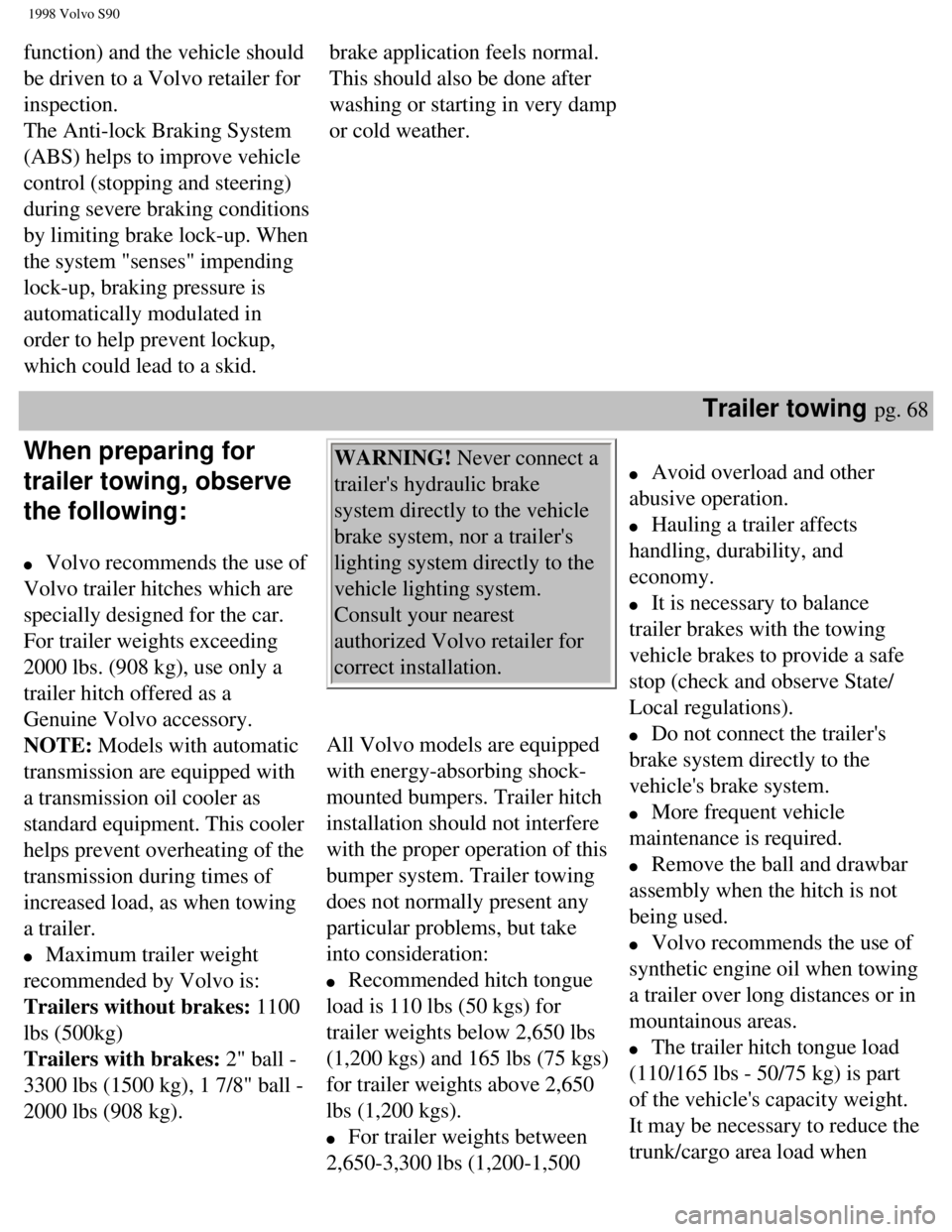1998 VOLVO V90 oil pressure
[x] Cancel search: oil pressurePage 2 of 175

1998 Volvo S90
Volvo Canada Ltd.
175 Gordon Baker Road
Willowdale, Ontario M2H 2N7
800-663-8255
Volvo and the environment
Volvo is committed to the well being of our
customers. As a natural part of this
commitment, we care about the environment in
which we all live. Caring for the environment
means an everyday involvement in reducing
our environmental impact.
Volvo's environmental activities are based on a
holistic view, which means we consider the
overall environmental impact of a product
throughout its complete life cycle. In this
context, design, production, product use, and
recycling are all important considerations.
In production, Volvo has partly or completely
phased out several chemicals including freons,
lead chromates, naphtanates, asbestos, mercury
and cadmium; and reduced the amount of
chemicals used in our plants 50% since 1991.
In use, Volvo was the first in the world to
introduce into production a three-way catalytic
converter with a Lambda sond, now called
oxygen sensor, in 1976. The current version of
this highly efficient system reduces emissions
of harmful substances (CO, HC, NOx) from
the exhaust pipe by approximately 95% and
the search to eliminate the remaining
emissions continues. Volvo is the only
automobile manufacturer to offer CFC-free
retrofit kits for the air conditioning system for
all models back to the M/Y 1975 240.
Advanced electronic engine controls, refined
purification systems and cleaner fuels are
In addition to continuous environmental
refinement of conventional gasoline-powered
internal combustion engines, Volvo is actively
looking at advanced technology alternative-
fuel vehicles.
When you drive a Volvo, you become our
partner in the work to lessen the car's impact
on the environment.
To reduce your vehicle's environmental
impact, you can:
l Maintain proper air pressure in your
tires. Tests have shown decreased fuel
economy with improperly inflated tires
l Follow the recommended maintenance
schedule
l Drive at a constant speed
l See an authorized Volvo retailer as
soon as possible for inspection if the
check engine (malfunction indicator)
lamp illuminates, or stays on after the
vehicle has started
l Properly dispose of any vehicle related
waste such as used motor oil, used
batteries, brake pads, etc.
l When cleaning your car, use Volvo's
own car care products, all of which
have systematically been adapted to the
environment
file:///K|/ownersdocs/1998/1998_SV90/98S90_000.htm (2 of 4)12/30/2006 \
1:52:33 PM
Page 25 of 175

1998 Volvo S90
Chapter 2 - Instruments, switches and controls (cont.)Indicator and warning lights
pg. 17
1 Turn signal, left
2 Turn signal, right
3 Malfunction indicator
lamp
4 Direction indicator,
trailer
5 Service reminder
indicator
6 Low washer fluid level
If the lamp glows continuously
when the engine is running,
there is only about 1/2 - 1 US
qts. remaining in the washer
fluid reservoir.
7 Rear fog light
8 Bulb failure
9 Generator not charging
10 Low engine oil pressure
11 High beams
12 Brake failure
13 Parking brake applied
14 ABS-system
15 Low coolant level
16 (Not in use)
17 "Winter" mode engaged/
transmission fault
18 Fasten seat belts
19 SRS
20 (Not in use)
21 (Not in use)
Warning lights
pg. 18
file:///K|/ownersdocs/1998/1998_SV90/98S90_017.htm (1 of 7)12/30/2006 \
1:52:36 PM
Page 26 of 175

1998 Volvo S90
The warning lights described on pages 18 and 19 should never stay on whe\
n driving
When the ignition key is turned on, and before the engine starts, all of\
the warning lights should be on
to test the function of the bulbs. Should a light not go off after the e\
ngine has started, the system
indicated should be inspected. However, the parking brake reminder light\
will not go off until the
parking brake is fully released.
Generator warning
light
If the light comes on while the
engine is running, have the
charging system checked.
Malfunction
indicator lamp
If the lamp comes on (or stays
on after the vehicle has started),
the engine diagnostic system
has detected a possible fault in
the emission control system.
Although driveability may not
be affected, see an authorized
Volvo retailer as soon as
possible for inspection.
NOTE:If the fuel filler cap is
not closed tightly or if the
engine is running when the car
is refueled, the Malfunction
Indicator Lamp may indicate a
fault. Use only Volvo original
or approved fuel filler caps.
Oil pressure warning
light
If the light comes on while
driving, stop the car and then s
If the light stays on after restart,
have the car towed to the
nearest authorized Volvo
retailer. After hard driving, the
light may come on occasionally
when the engine is idling. This
is normal, provided it goes off
when the engine speed is
increased.
Parking brake
reminder light
This light will be on when the
parking brake (hand brake) is
applied. The parking brake
lever is situated between the
front seats. Canadian models
are equipped with this warning
light:
Brake failure
warning light
If the light comes on while
driving or braking, stop
immediately, open the hood and
check the brake fluid level in the
reservoir. See page 114 for
reservoir position.
Canadian models are equipped
with this warning light:
WARNING!
If the level is below the MIN
mark in either section of the
reservoir: DO NOT DRIVE.
Tow the car to a Volvo
retailer and have the brake
system checked and any
leakage repaired.
Warning lights (cont.) pg. 19
file:///K|/ownersdocs/1998/1998_SV90/98S90_017.htm (2 of 7)12/30/2006 \
1:52:36 PM
Page 63 of 175

1998 Volvo S90
Volvo allows the use of the
following "oxygenated fuels";
however, the octane ratings
listed on this page must still be
met. of fuel. Therefore, it is
advisable to refuel as soon as
possible when the needle nears
the red zone, or when the fuel
warning light comes on.
Driving economy pg. 56
Economical driving
conserves natural
resources
Better driving economy may be
obtained by thinking ahead,
avoiding rapid starts and stops
and adjusting the speed of your
vehicle to immediate traffic
conditions. Observe the
following rules:
l Bring the engine to normal
operating temperature as soon
as possible by driving with a
light foot on the accelerator
pedal for the first few minutes
of operation. A cold engine
uses more fuel and is subject to
increased wear.
l Whenever possible, avoid
using the car for driving short
distances. This does not allow
the engine to reach normal
operating temperature.
l Drive carefully and avoid
rapid acceleration and hard
braking.
l Do not exceed speed limit.
l Avoid carrying unnecessary
items (extra load) in the car.
l Check tire pressure regularly
l Remove snow tires when
threat of snow or ice has ended.
l Note that roof racks, ski
racks, etc., increase air
resistance and thereby fuel
consumption.
l Avoid using automatic
transmission kick-down feature
unless necessary.
l Avoid using the air
conditioning when it is not
required. When engaged, the
air conditioner's compressor
places places an additional load
on the engine. However, please
note that fuel consumption is
lower with the air conditioning
on than it is when driving with
the air conditioning switched
off and the windows down.
Other factors which decrease
gas mileage are:
l Worn or dirty spark plugs
l Incorrect spark plug gap
l Dirty air cleaner
l Dirty engine oil and clogged
oil filter
l Dragging brakes
l Incorrect front end alignment
Some of the above mentioned
file:///K|/ownersdocs/1998/1998_SV90/98S90_053.htm (4 of 6)12/30/2006 \
1:52:41 PM
Page 64 of 175

1998 Volvo S90
(check when tires are cold). items and others are checked at
the standard Maintenance
Service intervals.
NOTE: Since using (D)rive
improves fuel economy, it
should be used as often as
possible.
Starting the engine pg. 57
Starting and stopping a
car equipped with
automatic transmission
1 Fasten the seat belt.
WARNING! Before
starting, check that the seat
is adjusted properly. Make
sure the brake pedal can be
depressed completely. Move
the seat closer if necessary.
Refer to section "Front
seats".
2 Apply the parking brake, if
not already set. The gear
selector is locked in the (P)ark
position (SHIFTLOCK).
3Without touching the
accelerator pedal ,turn the
ignition key to the starting
position. Allow the starter to
operate for 5-10 seconds.
Release the key as soon as the
engine starts. If the engine fails
to start, repeat step 3.
5 Select desired gear. The gear
engages after a slight delay,
especially noticeable when
selecting R.
CAUTION: Engine should
be idling; never accelerate
until after you feel the gear
engage! Too rapid
acceleration immediately
after selecting a gear will
cause harsh engagement and
premature transmission
wear.
NOTE:Your car is equipped
with a KEYLOCK system.
When the engine is switched
off, the gear selector must be in
the (P)ark position before the
key can be removed from the
ignition switch.
Engine warm-up - initial
driving procedure
Engines in vehicles driven short
distances are subject to
abnormally rapid wear because
the engine never reaches normal
operating temperature. It is
therefore beneficial to reach
normal operating temperature as
soon as possible. This is best
achieved by driving with a light
foot on the accelerator pedal for
a few minutes after starting,
rather than prolonged idling.
B6304 S Engine
This engine features hydraulic
valve lifters which means that
valve clearance is adjusted
automatically. It is possible that
the valve lifters will produce a
ticking sound for the first few
seconds after the engine is
started, while the oil pressure is
increasing.
If the car has not been used for a
long period of time, this ticking
sound may last for up to 15
minutes. This is entirely normal.
file:///K|/ownersdocs/1998/1998_SV90/98S90_053.htm (5 of 6)12/30/2006 \
1:52:41 PM
Page 73 of 175

1998 Volvo S90
Chapter 4 (cont)
Emergency towing (pulling of vehicles)
pg. 63
Precautionary steps to observe when car is in tow
l Steering must be unlocked.
l Please check with state and local authorities before attempting this typ\
e of towing, as vehicles being
towed are subject to regulations regarding maximum towing speed, length \
and type of towing device,
lighting, etc.
l Remember that power brake and power steering assists will not be availab\
le when engine is
inoperative. Brake pedal pressure required is 3 - 4 times above normal a\
nd greater steering effort must
be exerted.
l Gear selector in position N. Check transmission oil level (see section \
titled "Transmission oil").
l Maximum speed: 20 mph (30 km/h).
l Maximum distance with rear wheels on ground: 20 miles (30 km).
l If the battery is dead, it is not possible to release the gear selector \
by pressing the brake pedal.
Release the gear selector manually, see page 61.
Cars equipped with automatic transmission/three-way catalytic converters\
cannot be started by pushing
or pulling the car.
CAUTION: The towing eyelets must not be used for pulling another vehicle\
out of a ditch or any
similar purpose involving severe strain.
Do not attempt to start the car by pushing or pulling it as damage to th\
e three-way catalytic converter
can result.
Vehicle towing information pg. 64
file:///K|/ownersdocs/1998/1998_SV90/98S90_063.htm (1 of 4)12/30/2006 \
1:52:43 PM
Page 78 of 175

1998 Volvo S90
function) and the vehicle should
be driven to a Volvo retailer for
inspection.
The Anti-lock Braking System
(ABS) helps to improve vehicle
control (stopping and steering)
during severe braking conditions
by limiting brake lock-up. When
the system "senses" impending
lock-up, braking pressure is
automatically modulated in
order to help prevent lockup,
which could lead to a skid. brake application feels normal.
This should also be done after
washing or starting in very damp
or cold weather.
Trailer towing pg. 68
When preparing for
trailer towing, observe
the following:
l Volvo recommends the use of
Volvo trailer hitches which are
specially designed for the car.
For trailer weights exceeding
2000 lbs. (908 kg), use only a
trailer hitch offered as a
Genuine Volvo accessory.
NOTE: Models with automatic
transmission are equipped with
a transmission oil cooler as
standard equipment. This cooler
helps prevent overheating of the
transmission during times of
increased load, as when towing
a trailer.
l Maximum trailer weight
recommended by Volvo is:
Trailers without brakes: 1100
lbs (500kg)
Trailers with brakes: 2" ball -
3300 lbs (1500 kg), 1 7/8" ball -
2000 lbs (908 kg).
WARNING! Never connect a
trailer's hydraulic brake
system directly to the vehicle
brake system, nor a trailer's
lighting system directly to the
vehicle lighting system.
Consult your nearest
authorized Volvo retailer for
correct installation.
All Volvo models are equipped
with energy-absorbing shock-
mounted bumpers. Trailer hitch
installation should not interfere
with the proper operation of this
bumper system. Trailer towing
does not normally present any
particular problems, but take
into consideration:
l Recommended hitch tongue
load is 110 lbs (50 kgs) for
trailer weights below 2,650 lbs
(1,200 kgs) and 165 lbs (75 kgs)
for trailer weights above 2,650
lbs (1,200 kgs).
l For trailer weights between
2,650-3,300 lbs (1,200-1,500
l Avoid overload and other
abusive operation.
l Hauling a trailer affects
handling, durability, and
economy.
l It is necessary to balance
trailer brakes with the towing
vehicle brakes to provide a safe
stop (check and observe State/
Local regulations).
l Do not connect the trailer's
brake system directly to the
vehicle's brake system.
l More frequent vehicle
maintenance is required.
l Remove the ball and drawbar
assembly when the hitch is not
being used.
l Volvo recommends the use of
synthetic engine oil when towing
a trailer over long distances or in
mountainous areas.
l The trailer hitch tongue load
(110/165 lbs - 50/75 kg) is part
of the vehicle's capacity weight.
It may be necessary to reduce the
trunk/cargo area load when
file:///K|/ownersdocs/1998/1998_SV90/98S90_067.htm (2 of 5)12/30/2006 \
1:52:43 PM
Page 79 of 175

1998 Volvo S90
Observe legal requirements of
the state in which the vehicles
are registered.
WARNING! Bumper-
attached trailer hitches must
not be used on Volvos, nor
should safety chains be
attached to the bumper.
Trailer hitches attaching to
the vehicle rear axle must
not be used. kgs) a top speed of 50 mph (80
km/h) should never be
exceeded.
l Increase tire pressure to
recommended full-load
pressure. See section "Wheels
and tires".
l Engine and transmission are
subject to increased loads.
Therefore, engine coolant
temperature should be closely
watched when driving in hot
climates or hilly terrain. Use
lower gear and turn off air
conditioner if temperature gauge
pointer enters the red range.
towing a trailer to ensure that the
max. permissible axle load or
gross vehicle weight are not
exceeded.
NOTE: Refer to section
"Automatic transmission" for
additional trailer hauling tips.
Winter driving pg. 69
Cold weather precautions
l If you wish to check your car before the
approach of cold weather, the following advice is
worth noting:
Make sure that the engine coolant contains at least
50 percent antifreeze: that is, 5.3 qts. (5 liters)
Volvo Genuine Coolant/Antifreeze. This gives
protection against freezing down to -31°F (-35°
C). See section "Coolant".
The use of "recycled" antifreeze is not approved
by Volvo. Different types of antifreeze may not be
mixed.
l Try to keep the fuel tank well filled - this
prevents the formation of condensation in the
tank.
In addition in extremely cold weather conditions it
is worthwhile to add fuel line de-icer before
refueling.
l The viscosity of the engine oil is important. Oil
with low viscosity (thinner oil) improves cold-
weather starting as well as decreasing fuel
consumption while the engine is warming up. For
winter use, 5W-30 oil, particularly the synthetic
type, is recommended.
Be sure to use good quality oil but do not use this
l The Volvo Washer Solvent should be diluted as
follows:
Down to 14°F (-10°C): 1 part anti-freeze and 4
parts water
Down to 5°F (-15°C): 1 part anti-freeze and 3
parts water
Down to 0°F (-18°C): 1 part anti-freeze and 2
parts water
Down to -18°F (-28°): 1 part anti-freeze and 1
part water
l Use lock spray or grease in the locks.
NOTE: Avoid the use of de-icing spray as they
can cause damage to the locks.
Automatic differential lock (certain
models)
The differential automatically locks at speed
between 3 - 25 mph (5 - 40 km/h) if either of the
drive wheels begins to lose traction. The
differential lock improves power distribution to
the drive wheels in slippery conditions, shifting
power to the wheel with best traction. It also
file:///K|/ownersdocs/1998/1998_SV90/98S90_067.htm (3 of 5)12/30/2006 \
1:52:43 PM